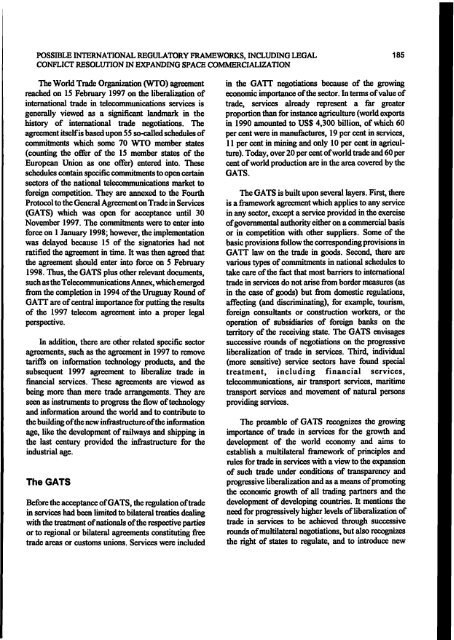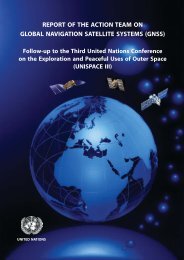Proceedings of the Workshop - United Nations Office for Outer ...
Proceedings of the Workshop - United Nations Office for Outer ...
Proceedings of the Workshop - United Nations Office for Outer ...
- No tags were found...
You also want an ePaper? Increase the reach of your titles
YUMPU automatically turns print PDFs into web optimized ePapers that Google loves.
POSSIBLE INTERNATIONAL REGULATORY FRAMEWORKS, INCLUDING LEGALCONFLICT RESOLUTION IN EXPANDING SPACE COMMERCIALIZATION185The World Trade Organization (WTO) agreementreached on 15 February 1997 on <strong>the</strong> liberalization <strong>of</strong>international trade in telecommunications services isgenerally viewed as a significant landmark in <strong>the</strong>history o f international trade negotiations. Theagreement itself is based upon 55 so-called schedules <strong>of</strong>commitments which some 70 WTO member states(counting <strong>the</strong> <strong>of</strong>fer <strong>of</strong> <strong>the</strong> 15 member states <strong>of</strong> <strong>the</strong>European Union as one <strong>of</strong>fer) entered into. Theseschedules contain specific commitments to open certainsectors o f <strong>the</strong> national telecommunications market t<strong>of</strong>oreign competition. They are annexed to <strong>the</strong> FourthProtocol to <strong>the</strong> General Agreement on Trade in Services(GATS) which was open <strong>for</strong> acceptance until 30November 1997. The commitments were to enter int<strong>of</strong>orce on 1 January 1998; however, <strong>the</strong> implementationwas delayed because 15 o f <strong>the</strong> signatories had notratified <strong>the</strong> agreement in time. It was <strong>the</strong>n agreed that<strong>the</strong> agreement should enter into <strong>for</strong>ce on 5 February1998. Thus, <strong>the</strong> GATS plus o<strong>the</strong>r relevant documents,such as <strong>the</strong> Telecommunications Annex, which emergedfrom <strong>the</strong> completion in 1994 <strong>of</strong> <strong>the</strong> Uruguay Round <strong>of</strong>GATT are <strong>of</strong> central importance <strong>for</strong> putting <strong>the</strong> results<strong>of</strong> <strong>the</strong> 1997 telecom agreement into a proper legalperspective.In addition, <strong>the</strong>re are o<strong>the</strong>r related specific sectoragreements, such as <strong>the</strong> agreement in 1997 to removetariffs on in<strong>for</strong>mation technology products, and <strong>the</strong>subsequent 1997 agreement to liberalize trade infinancial services. These agreements are viewed asbeing more than mere trade arrangements. They areseen as instruments to progress <strong>the</strong> flow <strong>of</strong> technologyand in<strong>for</strong>mation around <strong>the</strong> world and to contribute to<strong>the</strong> building o f <strong>the</strong> new infrastructure o f <strong>the</strong> in<strong>for</strong>mationage, like <strong>the</strong> development o f railways and shipping in<strong>the</strong> last century provided <strong>the</strong> infrastructure <strong>for</strong> <strong>the</strong>industrial age.The GATSBe<strong>for</strong>e <strong>the</strong> acceptance <strong>of</strong> GATS, <strong>the</strong> regulation o f tradein services had been limited to bilateral treaties dealingwith <strong>the</strong> treatment o f nationals <strong>of</strong> <strong>the</strong> respective partiesor to regional or bilateral agreements constituting freetrade areas or customs unions. Services were includedin <strong>the</strong> GATT negotiations because o f <strong>the</strong> growingeconomic importance o f <strong>the</strong> sector. In terms <strong>of</strong> value <strong>of</strong>trade, services already represent a far greaterproportion than <strong>for</strong> instance agriculture (world exportsin 1990 amounted to US$ 4,300 billion, <strong>of</strong> which 60per cent were in manufactures, 19 per cent in services,1 1 per cent in mining and only 10 per cent in agriculture).Today, over 20 per cent <strong>of</strong> world trade and 60 percent <strong>of</strong> world production are in <strong>the</strong> area covered by <strong>the</strong>GATS.The GATS is built upon several layers. First, <strong>the</strong>reis a framework agreement which applies to any servicein any sector, except a service provided in <strong>the</strong> exercise<strong>of</strong> governmental authority ei<strong>the</strong>r on a commercial basisor in competition with o<strong>the</strong>r suppliers. Some <strong>of</strong> <strong>the</strong>basic provisions follow <strong>the</strong> corresponding provisions inGATT law on <strong>the</strong> trade in goods. Second, <strong>the</strong>re arevarious types <strong>of</strong> commitments in national schedules totake care <strong>of</strong> <strong>the</strong> fact that most barriers to internationaltrade in services do not arise from border measures (asin <strong>the</strong> case <strong>of</strong> goods) but from domestic regulations,affecting (and discriminating), <strong>for</strong> example, tourism,<strong>for</strong>eign consultants or construction workers, or <strong>the</strong>operation o f subsidiaries o f <strong>for</strong>eign banks on <strong>the</strong>territory <strong>of</strong> <strong>the</strong> receiving state. The GATS envisagessuccessive rounds o f negotiations on <strong>the</strong> progressiveliberalization <strong>of</strong> trade in services. Third, individual(more sensitive) service sectors have found specialtreatm en t, in clu d in g fin an cial services,telecommunications, air transport services, maritimetransport services and movement <strong>of</strong> natural personsproviding services.The preamble o f GATS recognizes <strong>the</strong> growingimportance o f trade in services <strong>for</strong> <strong>the</strong> growth anddevelopment <strong>of</strong> <strong>the</strong> world economy and aims toestablish a multilateral framework <strong>of</strong> principles andrules <strong>for</strong> trade in services with a view to <strong>the</strong> expansiono f such trade under conditions <strong>of</strong> transparency andprogressive liberalization and as a means <strong>of</strong> promoting<strong>the</strong> economic growth <strong>of</strong> all trading partners and <strong>the</strong>development o f developing countries. It mentions <strong>the</strong>need <strong>for</strong> progressively higher levels <strong>of</strong> liberalization <strong>of</strong>trade in services to be achieved through successiverounds <strong>of</strong> multilateral negotiations, but also recognizes<strong>the</strong> right <strong>of</strong> states to regulate, and to introduce new
















